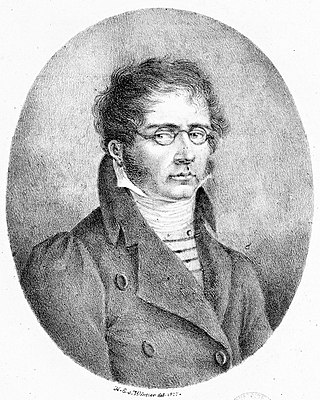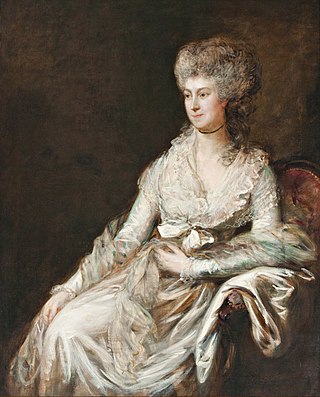
Franz Ignaz Danzi was a German cellist, composer and conductor, the son of the Italian cellist Innocenz Danzi (1730–1798) and brother of the noted singer Franzeska Danzi. Danzi lived at a significant time in the history of European music. His career, spanning the transition from the late Classical to the early Romantic styles, coincided with the origin of much of the music that lives in our concert halls and is familiar to contemporary classical-music audiences. As a young man he knew Wolfgang Amadeus Mozart, whom he revered; he was a contemporary of Ludwig van Beethoven, about whom he — like many of his generation — had strong but mixed feelings; and he was a mentor for the young Carl Maria von Weber, whose music he respected and promoted.

Carl Philipp Stamitz was a German composer of partial Czech ancestry. He was the most prominent representative of the second generation of the Mannheim School.

Mannheim school refers to both the orchestral techniques pioneered by the court orchestra of the Elector Palatine in Mannheim in the latter half of the 18th century and the group of composers of the early classical period, who composed for the orchestra of Mannheim. The father of the school is considered to be the Bohemian composer Johann Stamitz. Besides him, two generations of composers wrote compositions for the orchestra, whose reputation was due to its excellent discipline and the individual skill of its players; the English traveler Charles Burney called it "an army of generals". Their performance style included new dynamic elements, crescendos and diminuendos. Composers of the Mannheim school played an important role in the development of the classical period's genres and of the classical symphony form.

Johann Wenzel Anton Stamitz was a Bohemian composer and violinist. His two surviving sons, Carl and Anton Stamitz, were composers of the Mannheim school, of which Johann is considered the founding father. His music is stylistically transitional between Baroque and Classical periods.

Johann Christian Innocenz Bonaventura Cannabich, was a German violinist, composer, and Kapellmeister of the Classical era. A composer of some 200 works, he continued the legacy of Johann Stamitz and helped turn the Mannheim orchestra into what Charles Burney described as "the most complete and best disciplined in Europe.". The orchestra was particularly noted for the carefully graduated crescendos and diminuendos characteristic of the Mannheim school. Together with Stamitz and the other composers of the Mannheim court, he helped develop the orchestral texture that paved the way for the orchestral treatment of the First Viennese School.
Ignaz Jakob Holzbauer was an Austrian composer of symphonies, concertos, operas, and chamber music, and a member of the Mannheim school. His aesthetic style is in line with that of the Sturm und Drang "movement" of German art and literature.
Franz Ignaz von Beecke was a classical music composer born in Wimpfen am Neckar, Germany.

Anton Fils, 22 September 1733 (baptized) – 14 March 1760 (buried) was a German classical composer.

Francesca Lebrun was a noted 18th-century German singer and composer. She was renowned for her vocal dexterity and highly sought after by notable contemporaries, such as Anton Schweitzer, Ignaz Holzbauer, and Antonio Salieri, for the lead roles in their most challenging operas. Her talent extended beyond the stage to music composition and keyboard performance: as a composer, her twelve sonatas, six each in opus 1 and opus 2, for piano or harpsichord with violin accompaniment, were first published in London, England, in 1779–1781, with further editions in London, Paris, and several German centers. The opus 1 sonatas are available in commercial recording.
Anton Thadäus Johann Nepomuk Stamitz was a German composer and violinist.

London Mozart Players (LMP) are a British chamber orchestra founded in 1949. LMP are the longest-established chamber orchestra in the United Kingdom. Since 1989, the orchestra has been Resident Orchestra at Fairfield Halls, Croydon.
Mozart's Flute Quartet No.1 in D Major, K. 285 is written for flute, violin, viola and cello. It is the first of three quartets written in Mannheim, Germany at the request of Ferdinand De Jean who was introduced to Mozart by Christian Cannabich. Mozart first mentioned his quartets in a letter to his father, Leopold Mozart on December 10, 1777, and the first quartet is dated December 25, 1777.
Ernst Dietrich Adolph Eichner [Ernesto Eichner] was a German bassoonist and composer.

Ignaz Fränzl was a German violinist, composer and representative of the second generation of the so-called Mannheim School. Mozart, who heard him at a concert in November 1777, wrote of him in a letter to his father: He may not be a sorcerer, but he is a very solid violinist indeed. Fränzl carried the Mannheim violin technique, established by Johann Stamitz, one step further to real virtuosity. Mozart, quite a good violinist himself and thoroughly acquainted with the instrument, praised Fränzl's double trill and said he had never heard a better one.
Rose Cannabich (1764–1839) was a German classical pianist. Mozart dedicated a piano sonata to her when he was her teacher in Mannheim, where her father led the well-known orchestra.

The Sinfonia Concertante for Four Winds in E-flat major, K. 297b, is a work thought to be by Wolfgang Amadeus Mozart for oboe, clarinet, horn, bassoon, and orchestra. He originally wrote a work for flute, oboe, horn, bassoon, and orchestra, K. Anh. 9 (297B), in Paris in April 1778. This original work is lost.
Friedrich Ramm (1744–1813) was a German oboist for whom Wolfgang Amadeus Mozart wrote several works.
Jean-Georges Sieber was a German born French musician and music publisher.
Traditionally, a clarinet quartet is a chamber musical ensemble made up of one clarinet, plus the standard string trio of one violin, one viola and one cello. Nowadays, the term clarinet quartet can also refer to a combination of four clarinets of any size [including (contr)alto and (contra)bass clarinet, and basset horn]. The term is also used to refer to a piece written for any of these ensembles.










